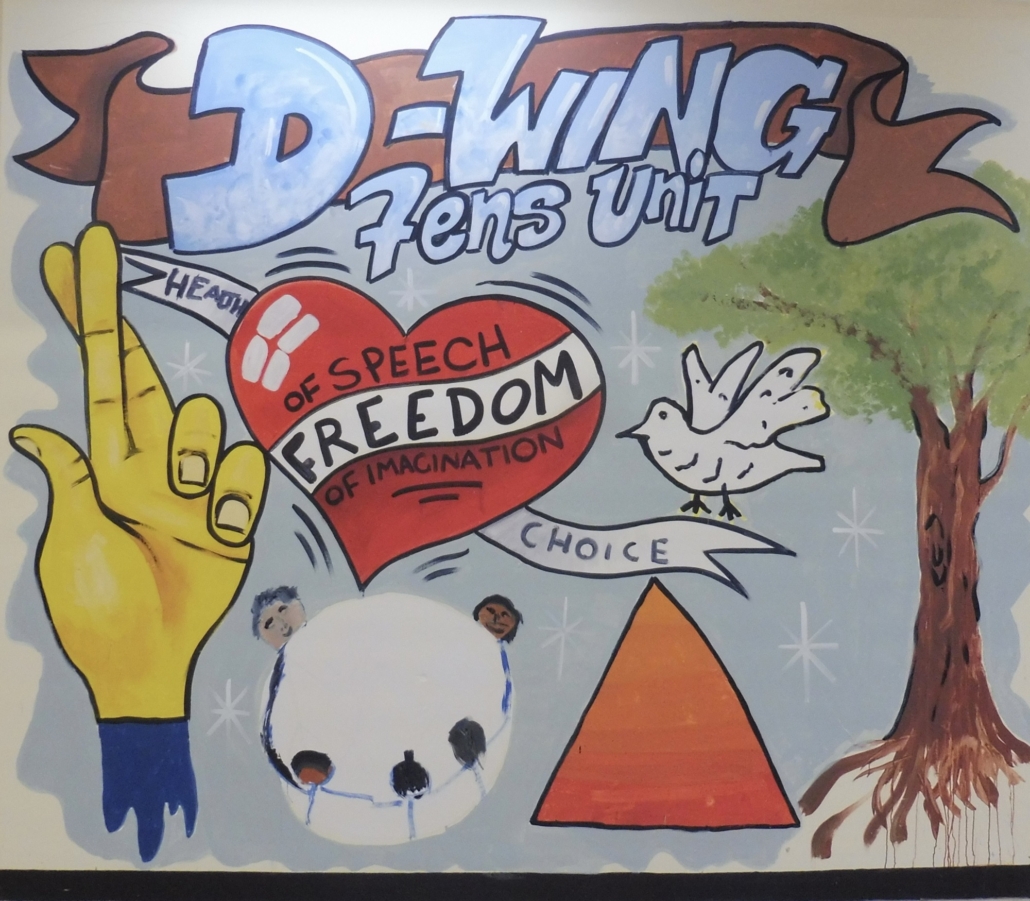Session 1
On arrival at the prison with Rebecca K. Greene, the project producer, I experienced an overwhelming sense of anxiety, something I hadn’t felt when working in other prison environments. On reflection, I think the airport-style security check, metal detectors, and pat-down served as a sobering reminder: any of us could, through a split-second decision, find ourselves in this situation. Typically, airport security is something I associate with the freedom that comes with travel and this experience was the antithesis of that.
With that being said, the staff, particularly Jason and Lou were incredibly welcoming. It was evident from the outset that a strong rapport had been built between staff and residents. After a brief introduction to my practice, and aware of the short eight-hour duration (spread across four sessions), we got to work generating ideas together and exploring themes for the mural.
Using a large sheet of brown paper that covered our table, we asked residents to draw or write three things that were important to them. Recurring themes included love, peace, good fortune, and freedom. I was pleased to see some participants drawing on personal motifs and symbols they enjoyed creating in their own time, weaving these into the early design of the mural.
Session 2
By the second session, strong design ideas had begun to take shape. In the latter half of the session, we began transferring these ideas onto the wall using graphite pencils. Together we negotiated how best to use the space, ensuring everyone’s contributions were included and that the overall composition worked as a whole. With the framework complete, the group continued developing the sketch in preparation for painting in the next session.
Session 3
Unfortunately, the third session didn’t go as planned due to supply chain issues, an understandable complication in a high-security setting. Instead, we used the session as an opportunity to draw and reflect together. Using more large brown paper, we continued to create freely. The mood was relaxed and reflective, enhanced by Rebecca playing her Rav Vast drum, with several residents (and myself) trying our hand at playing. It was a grounding and restorative experience.
Session 4
The final session was carefully planned leaving room for the inevitable improvisation and spontaneity. The mural was painted by mixing primary colors and black & white on site. It was all hands on deck with residents, prison officers and facilitators working diligently to complete the moral in the small two hour window. In this session we were joined by Brian, a prison officer who has been using art to process his own experiences and as a tool to support mental health. He was retiring soon and the mural was one of his last engagements. He saw the mural as part of the legacy of his time working there.
Residents contributed by painting parts and making suggestions in passing which was welcomed. It was fantastic that two residents, inspired by the mural and previous sessions (bubble painting, creative writing and soap carving sessions) were inspired to write a poem about their experience and then read them out to us.
Reflection
We were all really happy with the outcome. Most importantly the residents, including many who didn’t participate in the project, expressed how happy they were with the mural and as we left could see many handing over the wing balcony above critiquing it and debating the meaning of its different elements. I hope that, in some small way, this project shows what’s possible. We created an intimate and safe space for creativity, whilst balancing the demands of the project with the specific rules and constraints of the prison. A project such as this would always present challenges, but we are grateful for the engagement and contributions from all stakeholders. The level of participation, reflection, and creative expression from the residents, staff, and facilitators alike speaks volumes about the power of art to open dialogue and foster connection, even in the most controlled and complex of environments.


